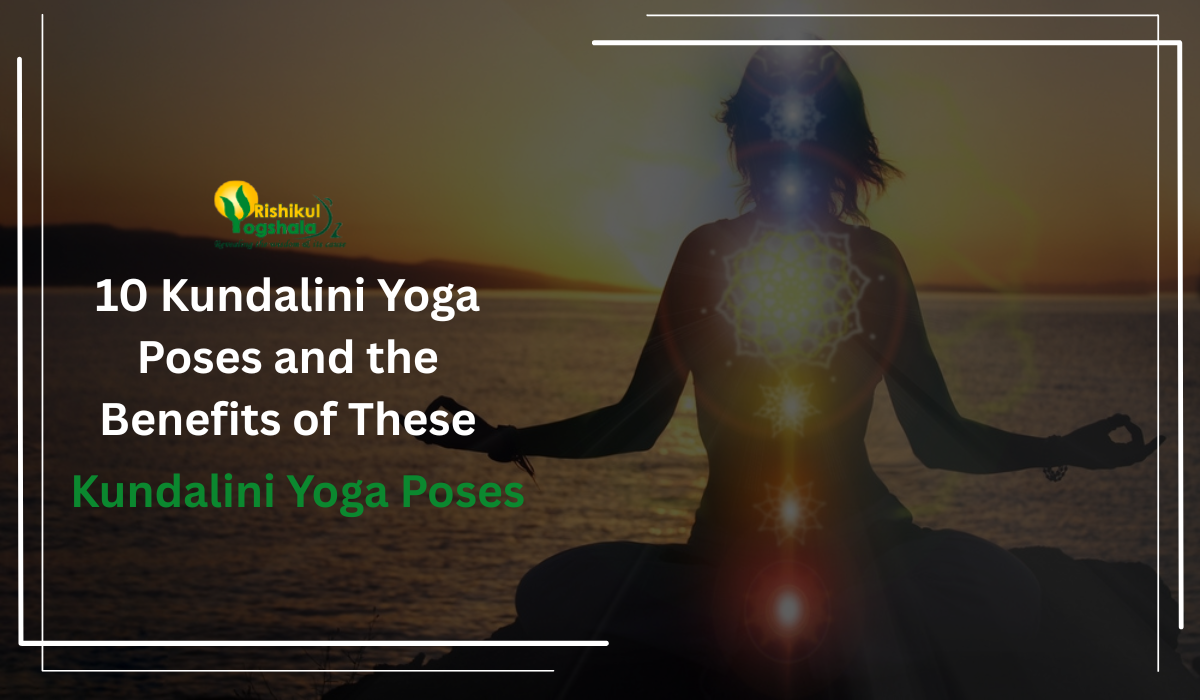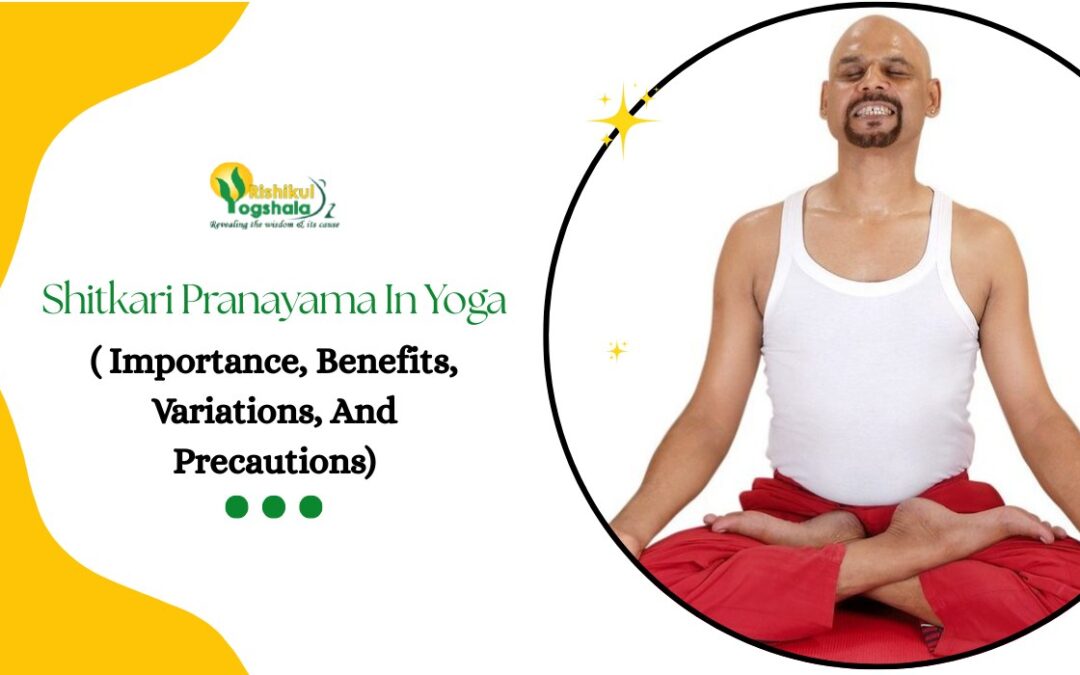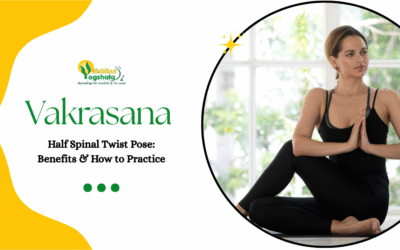What Is Kundalini Yoga?
Your life energy is said to be coiled like a snake at the bottom of your spine or the root chakra. In order to channel this powerful energy, there is an ancient yoga practice called Kundalini Yoga.
But what exactly is Kundalini Yoga (कुंडलिनी योग)? How can we practice them and reap their benefits? Let’s find out in this blog.
What Are The Kundalini Yoga Poses?
The Root (Muladhara) Chakra is the lowest chakra and is where the Kundalini energy is thought to be located. This dormant force said to be located at the base of the spine, is represented by a coiling snake that is dormant and asleep.
The seven chakras along the spine are crossed by Kundalini Shakti (energy), which leads to complete emancipation (Kaivalya). It liberates the soul and brings ecstasy, joy, and happiness. Kundalini Yoga is the practice that causes this energy to awaken.

Sign up for our 500 hour yoga teacher training program for more such yoga programs!
Pranayama (breathing), drishti (eye gazing), mantras (chanting), asanas (yoga positions), and mudras (hand movements) are all intertwined in Kundalini Yoga to link you with higher awareness. These methods are known as Kundalini kriyas when they are combined and practiced together.
- Kriya: A kriya is a series of positions, motions, or breath sequences that, when done in order, direct the body and mind to a certain goal.
- Pranayam: The exercise of controlling breath is known as pranayama. It’s a crucial part of Kundalini yoga, an activity that promotes both physical and emotional well-being.
- Drishti: During Kundalini yoga, your Drishti—the point of sight —is used to sharpen your focus and awareness.
- Mantra: In Kundalini yoga, formulations of sacred syllables called mantras are sung aloud or quietly. These make use of sound waves in your body for sound therapy.
- Mudra: The hand movements you do in your practice, known as mudras, operate as energy “seals” by using the electrical and magnetic polarities of your fingers and hands.
Now that we have a brief idea about kundalini yoga exercises in general, let us take a look at some of the easiest kundalini yoga postures. But before that, we must understand the benefits of practicing Kundalini yoga.
Kundalini Yoga Benefits
The benefits of Kundalini yoga practice are numerous:
1. Overall Health Benefits of Kundalini Yoga
Therapists can cure eating disorders like bulimia nervosa and anorexia nervosa by practising Kundalini Yoga (कुंडलिनी योग). Students who engage in this activity will grow in their confidence in themselves and their personalities. One gets more imaginative and sympathetic, and their charm improves. Generally speaking, one’s personality improves.
2. Mental Health Benefits of Kundalini Yoga
Kundalini yoga poses, like other types of yoga, can aid in reducing tension and anxiety. Numerous studies have found that Kundalini yoga may be a useful therapeutic option for those who suffer from generalized anxiety disorder (GAD).
3. Cognitive Health Benefits of Kundalini Yoga
Executive functioning, both short- and long-ter,m improves in kundalini poses practitioners. This comprises, among other things, cognitive flexibility, thinking, and problem-solving abilities.
10 Kundalini Yoga Poses for Beginners
Here are the 10 Kundalini yoga poses for beginners that you can practice at home:
- Archer Pose
- Breath of Fire
- Bow Pose
- Camel Pose
- Child’s Pose
- Cobra Pose
- Ego Eradicator
- Shoulder Twist
- Spinal Flexes
- Variation of Downward-Facing Dog Pose
Let us take a look at each of the Kundalini Yoga poses. We have also included a step-by-step guide for Kundalini Yoga for beginners.
1. Archer Pose
This Kundalini Yoga pose is great for boosting your willpower while also strengthening your core, shoulders, and hips. This is one of the beginner’s Kundalini Yoga pose, and here’s how you can practice it at home:
- Begin with the Tadasana or Mountain Pose and turn your right foot at a 45-degree angle.
- Take your right foot back and make sure that both your feet are flat. You may bend your left knee, but it shouldn’t go past your left foot.
- Lift both your arms to your shoulder, make a fist, and point your thumb upward.
- Twist your body to the left. Now bend your right elbow to bring your right fist close to your right armpit.
- Focus on your left thumb, breath, and hold this position for 2-3 minutes.
- Repeat on the opposite side as well.

2. Breath of Fire
Want to try out yoga to detoxify your body, and oxygenate your blood? If yes, then you have to try out Breath of Fire.
- Breath of Fire can simply seem like a breathing exercise, but it is much more than that! This is because this Kundalini yoga pose can strengthen your Solar Plexus Chakra — responsible for self-esteem and helps you feel in control of your life.
- Push your stomach outward with a little, focused force as you inhale.
- Bring your stomach up and towards your spine as you exhale, using the same light, deliberate pressure to let your air out.
3. Bow Pose
The bow position offers a large number of benefits, particularly for the overall digestive tract, but the kundalini yoga technique used when performing this posture is the actual key to maximizing its benefits. However, you shouldn’t jump to the advanced Kundalini yoga poses at first. It is recommended that you start with the beginner Kundalini yoga poses and gradually take things up a notch.

a. Bow Pose: Beginner Kundalini Yoga Poses
- To begin, place your chin on the ground while resting on your stomach.
- Aim for your ankles or the tops of your feet while bending your knees.
- Take a breath in and kick your shins outward to raise your torso and thighs above the ground.
- Extend your neck long and hold the position for two minutes.
- Release your breath.
b. Bow Pose: Advanced Kundalini Yoga Poses
- In a bow position, swing back and forth while breathing in as you move ahead and out as you move back.
Read More – Bow Pose (Dhanurasana): Steps and Benefits of The Bowing Pose
4. Camel Pose
- Camel Pose is used in a lot of Kundalini Yoga kriyas. The position opens up the abdomen, which aids with digestion and excretion. It helps to heal and balances the Navel Chakra, heals the Heart Chakra, and balances the Throat Chakra.
- Additionally, it strengthens the thighs and arms while opening up the hips.
- Rise up until your body is straight and you are resting on your shins and knees. Your hands should be on your hips.
- To stabilize your lower back, pull your stomach in.
- You should be able to ease your shoulder blades and softly press them into your back.
- As you inhale, raise your chest.
- Hold your hands there or let them fall back to your heels. Hold for a minute or two.
Read More – Experience Mind and Body Transformation with Camel Pose
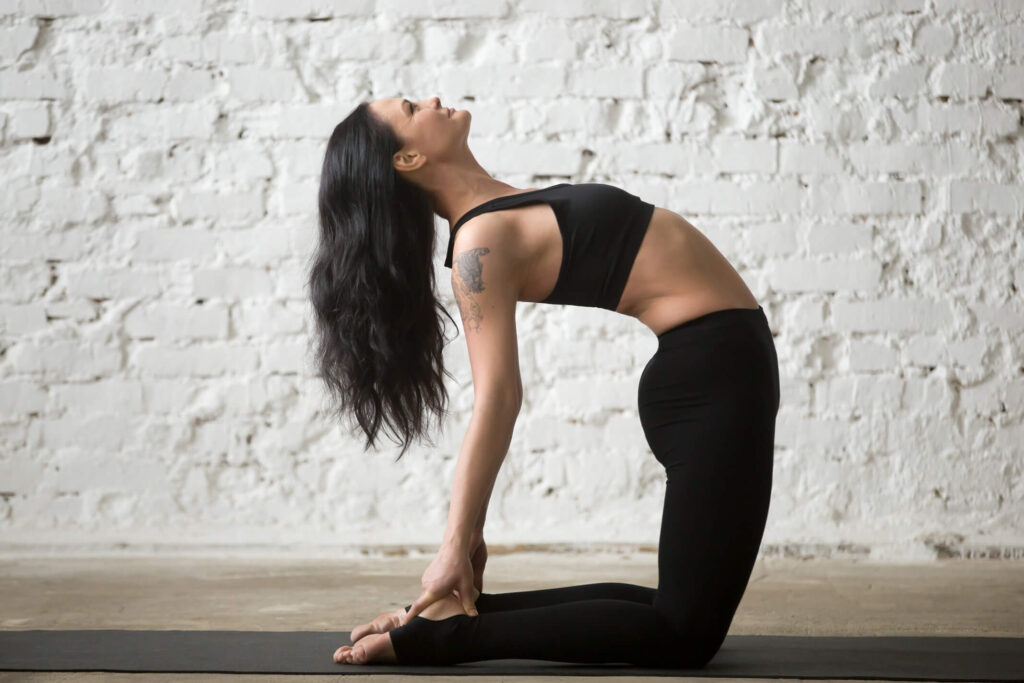
5. Child’s Pose
In Kundalini Yoga, the child’s posture is a fundamental asana. You’ll discover that this posture recurs often once you start practicing. There is a good reason why this one is such a hit. A child’s pose is a particularly potent asana since it offers numerous benefits.
- With your knees together, your hips supported by your heels, and your forehead resting on the floor, press into a Child’s Pose.
- Your hands should be shoulder distance apart when you stretch and rest your arms directly in front of you.
- Take a minute to unwind here, bringing your breathing back to its regular pace.
- then position your arms next to your body. Allow your breathing to return to normal as you unwind here for a minute.

6. Cobra Pose
One of the most exquisite Kundalini yoga poses that is simple to perform and offers a wealth of significant health advantages is the cobra pose. It is fantastic for controlling your digestion and toning other abdominal organs, in addition to being wonderful for the wellness and flexibility of your back and spine.
- With your legs and feet squeezed together, lie on your stomach. Your feet should be flat on the ground.
- your shoulders with your palms down. Ensure that your elbows are parallel to one another and that your fingers are facing forward.
- Inhale. Raise your head and torso while pressing the floor with your lower body.
- Lifting your chest and abdomen while keeping your arms straight put your shoulders back and down.
- As you hold Cobra, take a few deep breaths. Inhale, then release your breath and start over.
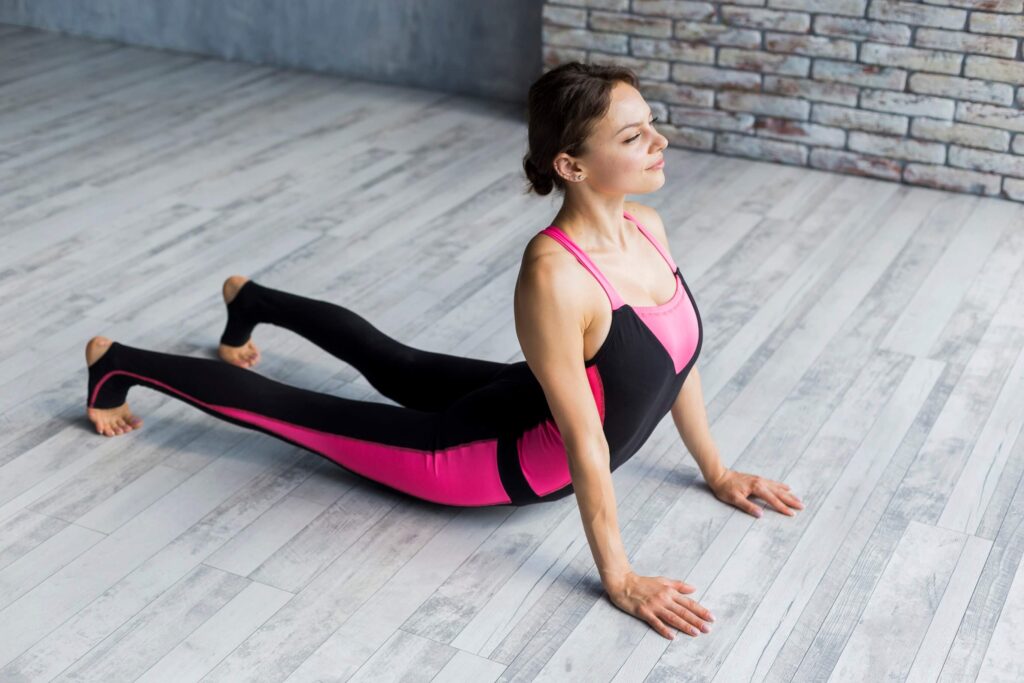
Read More – Cobra Yoga Pose (Bhujangasana): Benefits and Step-by-Step Guide
7. Ego Eradicator
By harmonizing the two halves of the brain and delivering a mental clarity that quiets the negative thoughts, this easy yet incredibly powerful exercise strengthens and purifies the lungs, opens the heart, and actually connects us to the higher realms.
- Stretch your fingers at the third knuckle while in Easy Pose (Sukhasana), so the tips of your fingertips lie where the palms meet the bases of your fingers.
- Put your thumbs up in the air and your arms outstretched 160 degrees over your head.
- Start your Breath of Fire by bringing your attention to the Third Eye Chakra.
8. Shoulder Twist
As the name implies, the Kundalini Twist Practice is a classic Kundalini Yoga pose. It is a breathing-synchronized twisting flow done while sitting. To help relax the mind and revitalize the body, this position gently lengthens the spine and opens the ribcage and sides of the torso.
- Put your right side’s fingertips on the right shoulder, then the left.
- Twist left and right while keeping your elbows parallel to the floor and in line with your shoulders.
- Breathe in left and right.
- As you turn, say Sat Nam in your brain (Sat on your left and Nam on your right)
- Allow your head to move naturally in conjunction with your spine.
9. Spinal Flexes
A sitting form of the cat-cow posture, known as seated cat-cow, is frequently practised by seniors and in chair yoga. You can gently bend the spine forward and back while sitting in a chair as opposed to being on your hands and knees on the floor. Thus the name, Spinal Flexes.
- Grab your knees or front ankle with both hands while in the easy seated position.
- Focus on the centre of your heart.
- Close your eyes and take a deep breath in to do the Cow Pose, pulling your heart forward, and a deep breath out to perform the Cat Pose.
10. Variation of Downward-Facing Dog Pose
A typical therapeutic yoga pose that lengthens your spinal muscles and revitalizes your entire body is the downward-facing dog.
This position—basically an inversion—allows energy to go in the direction of the brain.
- Enter a different version of the Downward-Facing Dog. Pose with your fingers angled out and your thumbs in contact.
- Maintain a hip distance between your feet.
- Lift the weight off of your shoulders by drawing your hips up and back while maintaining core stability.
- Breathe deeply for three minutes.
Closing Thoughts
Other forms of yoga are less spiritual than kundalini yoga. In contrast to other styles of yoga, Kundalini yoga incorporates precise rhythms of chanting, singing, movement, and breathing.
While some health improvements may be seen immediately, the greatest gains may be attained with dedication and consistent practice.
Practising Kundalini yoga offers a profound journey of self-discovery and transformation, unlocking your inner energy and bringing numerous physical, mental, and spiritual benefits. By incorporating these 10 Kundalini yoga poses into your routine, you can experience a deeper connection with your true self and harness the power within.
If you’re ready to take your practice to the next level and guide others on their spiritual path, consider enrolling in Rishikul Yogshala’s 100 Hour Yoga Teacher Training In Rishikesh, 200 Hrs Yoga TTC In Rishikesh, 300 Hour Yoga Teacher Training In Rishikesh, or the extensive 500 Hour Yoga Teacher Training Rishikesh. These programs are designed to deepen your understanding of kundalini yoga asanas and prepare you to share its transformative power with the world.

